Photographs: Reuters Arghya Ganguly
In Sanand, farmers are silent but happy spectators to their own transformation.
Out of nowhere, this village 35 km from Ahmedabad is emerging as India's latest Motown after Pune, Gurgaon and Chennai.
The Tata Motors factory, Sanand's claim to fame: can produce 250,000 Nanos in a day. Maruti Udyog, Ford and Hero Honda have indicated that they could set up shop here.
. . .
How the Nano factory has transformed Sanand!
Photographs: Reuters
Real estate developers like DLF and Parsvnath want to build residential complexes here. State government officials, smug over the successful transformation of Sanand, say that they own 29,000 more acres around the village for sale to other corporations.
About half of it is already sold, and 'the response is great for the remaining land'. Farmers thus walk about the village with spring in their steps, comfortable in the thought that a buyer will soon turn up for their land; those who have already sold zing off the newly-laid four-lane roads in their Audis and BMWs.
These new rich are the beneficiaries of the windfall brought about by the 'Giant Dwarf', the Nano plant of Tata Motors.
. . .
How the Nano factory has transformed Sanand!
Photographs: Reuters
Their behaviour -- glitzy houses and expensive cars -- is similar to farmers elsewhere in the country who have sold their land for large industrial projects or to real estate developers.
But the coming of the Nano was the defining moment for Sanand. Events of note, such as weddings and divorces, births and rebirths, deaths and near-deaths, murders and suicides, are spoken of and dated at the Sanand taluka by whether they happened before or after the inauguration of the Nano plant on June 2, 2010.
The influence of the Nano is profound in every sentient creature alive in the hamlet. You notice this when you enter the highly-sensitized $416.6-million factory on 1,100 acres that were previously a government-owned cow pasture.
. . .
How the Nano factory has transformed Sanand!
Photographs: Reuters
(It was set up by the British over 100 years ago when there was a famine in Gujarat and the bovine population threatened to fall sharply.)
Right after the main gate, on the left, is an artificial lake lending the plant a scenic look -- one of the unfactory-like features of this plant.
The lake, encircled by palm trees, is a fertile ground for the migratory birds who might want to take a detour from the nearby Nal-Sarovar Bird Sanctuary when it gets too crowded there.
. . .
How the Nano factory has transformed Sanand!
Photographs: Reuters
There is another natural lake inside the campus where orange-breasted birds try to catch the marine life with their beaks.
"One of the biggest gains to come out of the Nano project is that the environment in our village has improved drastically. The government is putting huge efforts into making Sanand a pollution-free zone. It has given notice to factories, small as well as large, that emit high levels of pollution in the area to either leave the village or treat the pollutants carefully," says Ravubha Vaghela, a farmer-turned-banker-turned-realtor-turned-industrialist and post-Nano the uncrowned king of the village for being the middleman between the government and the farmers.
Immediately after the Nano deal was sealed, Gujarat Industrial Development Corporation had taken six villages under acquisition in Sanand.
. . .
How the Nano factory has transformed Sanand!
Photographs: Reuters
Farmers were under the impression that the authorities will take away their land for free. In protest, about 3,000 of them took out a procession last year and threatened to end their lives if forced to give up their land.
Pointing out the gaucheness in their modus operandi, Vaghela advised the government to first tell the farmers the price on offer for their land and then try to convince them to sell.
Paying heed to this advice, the government declared the price of the land at Rs 1,200 per square meter at Bol (a village inside the Sanand Taluka), four-times better than the market price.
. . .
How the Nano factory has transformed Sanand!
Photographs: Reuters
The opposition crumbled -- the government smiled and Bol got richer by Rs 900 crore (Rs 9 billion) in a matter of days. Other villages were quick to understand the formula for untold riches, and invited GIDC to come and buy their land as well.
The flip side is that not many farmers are financially oriented to know how and where to invest the new-found wealth, the high literacy rate of over 70 per cent and proximity to stock-market-crazy Ahmedabad notwithstanding.
Thus, the uninitiated indulge in high-stakes games: their first instinct is to either erect a bungalow or sprint to a showroom and purchase a luxury car or even two.
. . .
How the Nano factory has transformed Sanand!
Photographs: Reuters
This is the reason why NGOs all across India are against one-time payments to farmers which can run into crores; instead, they advocate payment over a period of time.
Vaghela, who gave 30 out of the 50 acres needed to build the approach road from the Nano factory to National Highway 8 which connects Mumbai with Delhi, says he was willing to hand over the land for free due to his 'unconditional love for the Tata group'.
But he is disappointed that the villagers have not been given priority over outsiders for jobs at the plant. "The negative side to this whole development euphoria is that not many local people have got employment in the Nano plant. People from outside the village have got jobs here. And that's because the government and Tata Motors don't have a 'local employment' clause in the contract," says he.
. . .
How the Nano factory has transformed Sanand!
Photographs: Reuters
"Usually when you convert a property into non-agricultural land there is a clause stating that the factory has to give 80 per cent employment to locals. Since the clause isn't there, the locals have to look into other choices." Vaghela owns Raviraj Foils -- a company with an annual turnover of Rs 100 crore (Rs 1 billion) -- which employs more than 275 local workers.
Still, some boomtown signs are there. Ten banks have opened branches in the village after Nano. But the local market comprises only grocery stores; there is no sign of a Nano showroom -- so close yet so far!
For all lifestyle purchases, the villagers drive down to Ahmedabad; not in Nanos, but big cars and SUVs. A vendor park on 375 acres has come up at Sanand. At the moment, they all supply only to Tata Motors. Once others move in, they could supply to others as well.
. . .
How the Nano factory has transformed Sanand!
Photographs: Reuters
Automotive experts say that Tata Motors has worked hard with these vendors to make them produce at very low costs in order to keep the Nano affordable, and this is a big draw for other car makers.
The Nano's impact has permeated interpersonal relationships as well, creating fissures at times. "Brothers are fighting with each other for an equal portion of their father's land, and sometimes the sister too comes along to the police station to protest that she should get the land because she was closest to her deceased father and not her loafer brothers," says A R Desai, the inspector of the Sanand police station for the last ten months.
Recently-wed husband Govind is heard lodging a complaint, just outside Desai's room, against his runaway wife. It turns out that his wife has barged out since Govind has coated an exorbitant price for land her ex-boyfriend is interested in purchasing.
. . .
How the Nano factory has transformed Sanand!
Photographs: Reuters
The wife, certainly a headstrong woman, has refused to return home unless Govind behaves himself and sells the land at a reasonable price.
Govind, on the other hand, insists that his wife has not forgotten her old flame and makes a pantomime of taking an imaginary knife and stabbing at his heart.
After he has wailed for a few minutes, the cops are unsure whether the grievance is for his runaway wife, her supposed infidelity, or his wife's interference in Govind's basic right to sell the land at the market-determined rate.
. . .
How the Nano factory has transformed Sanand!
Photographs: Reuters
"Many offences have started taking place in the last one year with respect to land deals, like cheating and forged signatures on land papers, leading often to murders. Who is the owner? Who is the buyer? Both are creating the problem to each other about highly increasing the ratio of the land [sic] ," says Vaghela as his deputy whispers into your ear that "Sir is learning English nowadays since Sanand is fast becoming a city from a village".
Inside the Nano factory, as the guide takes you through the various stages of production, you marvel at the nimble hands and precise eyes of the workers who, in conjunction with robots, produce a 623cc car every less-than-a-minute.
For the record, 12 years ago, Matiz of Daewoo-make took a minimum of four minutes to be born.
. . .
How the Nano factory has transformed Sanand!
Photographs: Reuters
Tata Motor's reason for coming to Gujarat, apart from Chief Minister Narendra Modi's timely SMS to Ratan Tata after the Singur fiasco (to which Tata had famously said that he "wasn't stupid anymore to ignore such SMSes) and the obvious tax waive-off, is that six per cent of the country's GDP and 16 per cent of industrial production occurs in the state.
Melancholy is an emotion that farmers in Sanand appear to have left behind, unlike their counterparts in Singur.
Here, they are riding the crest of a high and beautiful wave, one in which they have sown the seeds of transformation.

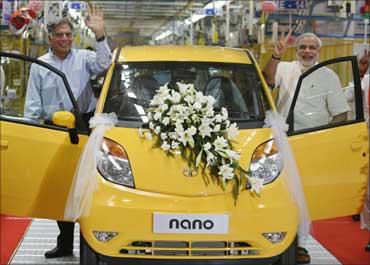
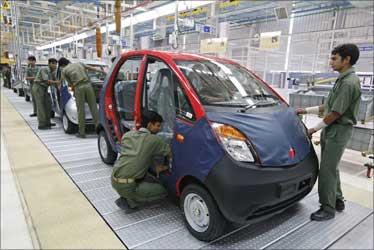

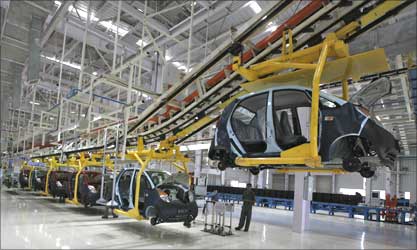
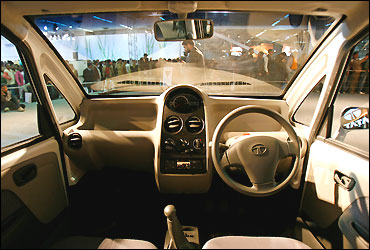
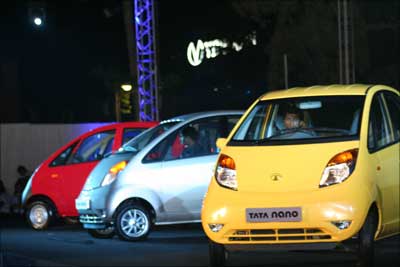
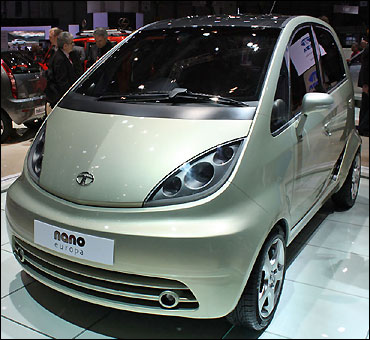
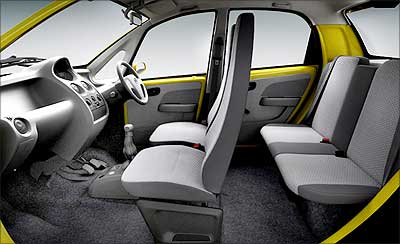
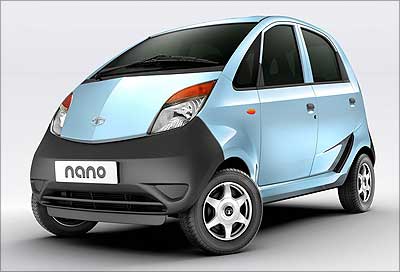
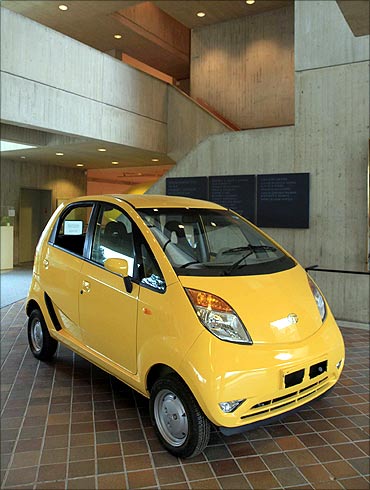
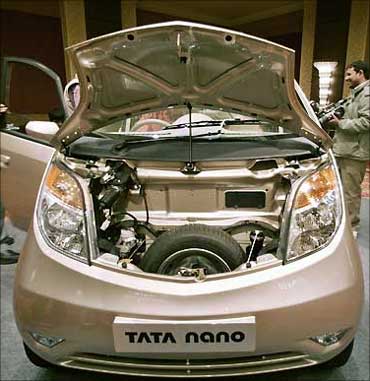
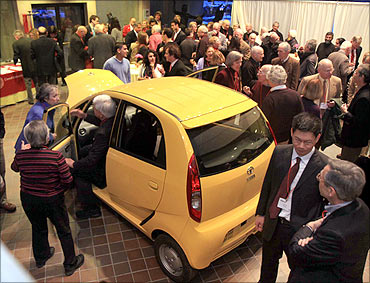
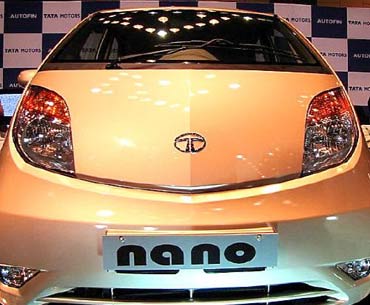

article